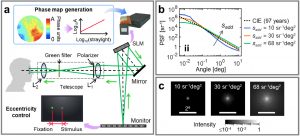Abstract
Both cataracts and age-related macular degeneration (AMD) may occur with aging and are often developed simultaneously. We performed a study to better characterize the impact of induced scatter on the quality of vision in the near periphery, a region where individuals with AMD typically maintain their functional vision. We used an optical instrument as a cataract simulator based on projecting at the eye’s pupil plane phase masks with controlled spatial properties generated with a spatial light modulator. The phase wavefronts were designed to accurately replicate the angular distribution of light intensity in the retina found in cataractous eyes with different severities. The induced amount of scatter ranged from values of straylight (S) from 10 to 85 degree2/sr, which corresponds from normal aging eye to advanced cataract stages. Mesopic visual acuity (VA) and contrast sensitivity (CS) at 3 cycles per degree were measured at the fovea and two retinal eccentricities (5 and 10 degrees in nasal visual field). We observed a consistent linear decline in VA (expressed in LogMAR) as the amount of induced scatter (quantified by the straylight parameter S) increased, both at the fovea and in the periphery. The effect of induced scattering on mesopic VA and CS at the fovea and the near periphery was evaluated. We found a relatively lower impact of scatter in the near periphery. This may explain the modest improvement in vision often found after cataract surgery in patients with AMD.
© 2024 Optica Publishing Group under the terms of the Optica Open Access Publishing Agreement


